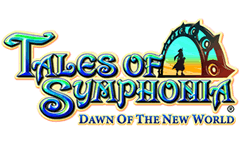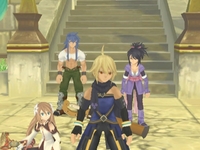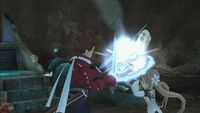|
|

|
PLATFORM
|
Wii
|
BATTLE SYSTEM
|

|
INTERACTION
|

|
ORIGINALITY
|

|
STORY
|

|
MUSIC & SOUND
|

|
VISUALS
|

|
CHALLENGE
|
Moderate
|
COMPLETION TIME
|
40-60 Hours
|
|
OVERALL

|
+ Sequel to the greatest game ever made!
+ Likeable main characters with a great romance.
+ Monster collecting is fun.
- Graphics engine is terrible.
- Story is heavily reliant on knowledge of original Tales of Symphonia.
|
Click here for scoring definitions
|
|
|
Whenever a new Tales game is announced, I get really antsy and stay that way for a long time. Namco-Bandai is fairly sketchy when it comes to bringing new entries of their flagship roleplaying series to North America, and when it was announced that a sequel was in the works for what is considered by many to be the series' pinnacle — its Final Fantasy VII, if you will — a stage was set to either delight or crush my ever-so-fragile hopes. It is no secret that Tales of Symphonia is my all-time favorite game. I cannot say what exactly about it I loved so much. Its voice acting was stale, its characters were mostly one-dimensional and often irritating, but the entire game had a charm to it that no entry in the series has yet been able to match in my eyes. Tales of Symphonia: Dawn of the New World is a direct sequel to the hit GameCube title, and it more than lives up to its predecessor. Although it has a fair number of flaws, like Tales of Symphonia, the end product succeeds in spite of them.
Dawn of the New World takes place two years after the events of Tales of Symphonia. After Lloyd and his friends reunited the two worlds of Sylvarant and Tethe'alla, the people of the world haven't yet adjusted to their new circumstances. The technological gap between the two worlds has lead to Tethe'allans looking down upon the people of Sylvarant, and things have turned violent. A upstart group of rebels calling themselves the Vanguard is at odds with the Royal Army of Tethe'alla and the struggling Church of Martel. As the game begins, the Sylvarant port town of Palmacosta is attacked and burned by the Church of Martel, with the assault being lead by none other than former hero Lloyd Irving. After watching his parents die at Lloyd's hands, timid protagonist Emil finds himself, six months later, under the care of his abrasive aunt and uncle in Luin.
To make things worse, weather around the world has begun to change dramatically. Luin's Lake Sinoa has dried up, Triet desert has been blanketed with snow, and the ice fields of Flanoir are beginning to melt. These events coincided with Emil's arrival in Luin, and as a result, he finds himself an outcast. However, he doesn't remain in Luin long, as he soon joins up with a rather energetic girl named Marta who claims to know the true reason for the odd weather around the world.
Much like Tales of Symphonia, Dawn of the New World often deals with themes of ostracization and social structure. However, these themes tend to be limited to the background, and in most cases, Dawn of the New World tells a story about a kid at odds with himself, torn by what he wants to do, what he has to do, and what he fears to do. As the story progresses, Emil grows from a timid kid who can't stand up for himself into a decisive hero. This change is slow, happening gradually and believably, and is heightened by the excellent voicework of Johnny Yong Bosch. As far as the plot is concerned, it is, like its predecessor, driven fairly heavily by RPG clichés, most notably that of elemental collection. However, the collection aspect of the story is done in a much more indirect way than in Tales of Symphonia, and the items in question often fall into the hands of villains. The story also features a twist near the end that easily rivals and even surpasses those from Symphonia, but disappointingly, several plot holes appear in its aftermath that are never satisfactorily explained.
 New and familiar faces.
New and familiar faces.
|
|
Dawn of the New World also tells an excellent love story, quite possibly the best in the series. The chemistry between Emil and Marta is excellent, and their contrasting personalities lead to some of the funniest (fully-voiced) skits in the series. They are not alone in their adventure, of course, as the game's party also includes Centurion Tenebrae, a spirit monster that plays a role similar to Mieu of Tales of the Abyss, and regular appearances from the original Tales of Symphonia cast. Interestingly, although none of the characters from Tales of Symphonia receive much in the ways of new development, Lloyd is a major exception, who has changed dramatically in the two game years that have passed. While he hasn't completely lost his idealistic sentiments, he has apparently been struck by a cold dose of reality, which ends up putting him in a villainous role. He is much more complex than before, and the game is better for it.
Being a Tales game, most people probably know exactly what to expect from the gameplay. Tales of the Abyss's Free-Range Linear Motion Battle System returns for its fourth game, as do several other features from both Abyss and Vesperia, including their skill equipping systems and Vesperia's wonderful item creation system. The latter, unfortunately, is not quite as large or user-friendly as Vesperia's, but it's still a step above most other Tales games. The only significant change to combat is in Emil's fighting style, which is fairly different from the majority of Tales protagonists. While he still fights with a sword and has many of the same special attacks, Emil is strongest in the air, and most of the skills he learns enhance his aerial fighting abilities. Some players will be disappointed to hear, however, that only Emil and Marta are controllable in combat. There is a workaround using the battle menu that allows the player to control guest Symphonia characters, but it is awkward and unlikely to be discovered by most players. The rest of the party is generally composed of monsters, one of Dawn of the New World's more original features.
Monster collection has almost become a sub-genre of its own within RPGs, but this is the first time it has been included in a Tales game. Dawn of the New World borrows many ideas from other monster-collecting games, particularly the Pokémon series, but it brings enough new ideas to the table that it manages to feel unique. The method for capturing monsters is very different, in particular. Every battlefield in Dawn of the New World has a major element and five minor elements. Whenever an elemental arte is performed, either by the player's party or an enemy, a minor element changes. When three of the minor elements are the same, the major one changes, clearing the minor elements in the process. If an enemy is defeated while four of the minor elements match the major element, there is a chance that the monster will join the party at the end of the battle.
While it sounds fairly complex, it's actually rather easy to figure out. Unfortunately, the game doesn't provide the player with the tools to make proper use of it until late in the game. Specifically, Emil never actually learns any elemental artes. Instead, as the story progresses, he gains skills that add elemental attributes to certain attacks. The first of these skills arrives several hours into the game, and up to that point the player is forced to rely on battlefields randomly appearing with a full set of elements to acquire monsters, which can be rather frustrating. As the game progresses, it becomes easier to do.
 Attacking an innocent girl? What's happened to you, Lloyd?
Attacking an innocent girl? What's happened to you, Lloyd?
|
|
While Emil and Marta level at a typical rate, monsters require far less experience to level up. All new monsters begin at level one, so this is really a blessing. What's more, at certain levels, most monsters can evolve into an advanced form. The evolved monster also begins at level one, but retains twenty percent of its former stats. Even more unusual, fully evolved monsters are eventually able to evolve back into their original form, which means that players can potentially carry stats over indefinitely to create the ultimate monster. Monster companions also tie into the returning cooking system, which is actually far more important than in any previous Tales game. Rather than restoring health, monsters can be fed a variety of dishes once per level to permanently increase their stats. Whether a player evolves their monster back to its original form or not, monster companions will almost always have significantly improved stats and levels compared to the human characters. Luckily, the game is still quite challenging, as bosses are devastating, monster companions can't use items, and the game ends even if only Marta and Emil are defeated.
Dawn of the New World's soundtrack is mostly reassembled from Tales of Symphonia. Symphonia's soundtrack was quite good, however, although fairly similar to Motoi Sakuraba's other works, so it's not really a bad thing. There are a few new tracks, but it would have been nice to have more. The voice acting is decent as well. While some characters don't quite come off right, Emil, Marta, and Tenebrae, thankfully, are done wonderfully. It should be noted that many of the original Tales of Symphonia characters have been recast. Lloyd, in particular, is voiced much better than in the previous game. Despite the efforts of the voice cast, unfortunately, typical JRPG over-extrapolation plagues much of the dialogue, which can lead to a few cringe-inducing moments. When the game shies away from serious conversation, however, the dialogue is quite natural, leading to several very amusing scenes and skits.
The visuals are a bit of a disappointment. While the art style and character designs are solid, the game's engine is simply not up to snuff. Aliasing problems persist throughout the game, and in certain cutscenes, the background shimmers as the camera pans, creating a very disorienting effect. While the game thankfully suffers no slowdown during gameplay, loading times are unacceptably long and frequent, often lasting several seconds just to begin a battle. Aside from the opening video, the game also doesn't feature any anime cutscenes, which is rather disappointing.
Tales of Symphonia: Dawn of the New World's biggest drawback is simply that it's a direct sequel to Tales of Symphonia. While this provides the game with a fairly large potential audience of fans, the story draws very heavily from the events of the first game, and while it's possible to pick up the pieces during the game, those who haven't played Tales of Symphonia will likely find themselves lost. Dawn of the New World is a game made for Tales of Symphonia fans, and isn't likely to find an audience outside of that. The game lasts roughly forty hours, and is surprisingly challenging. The game's difficulty can be increased for those seeking additional challenge, but cannot be decreased from its default setting, which should provide plenty of challenge for the typical gamer. If you're a rabid Tales of Symphonia fan like myself, Dawn of the New World could easily be your game of the year. However, its flaws are noticeable, and most people will find it an enjoyable, if somewhat unremarkable, experience.
Review Archives
|









